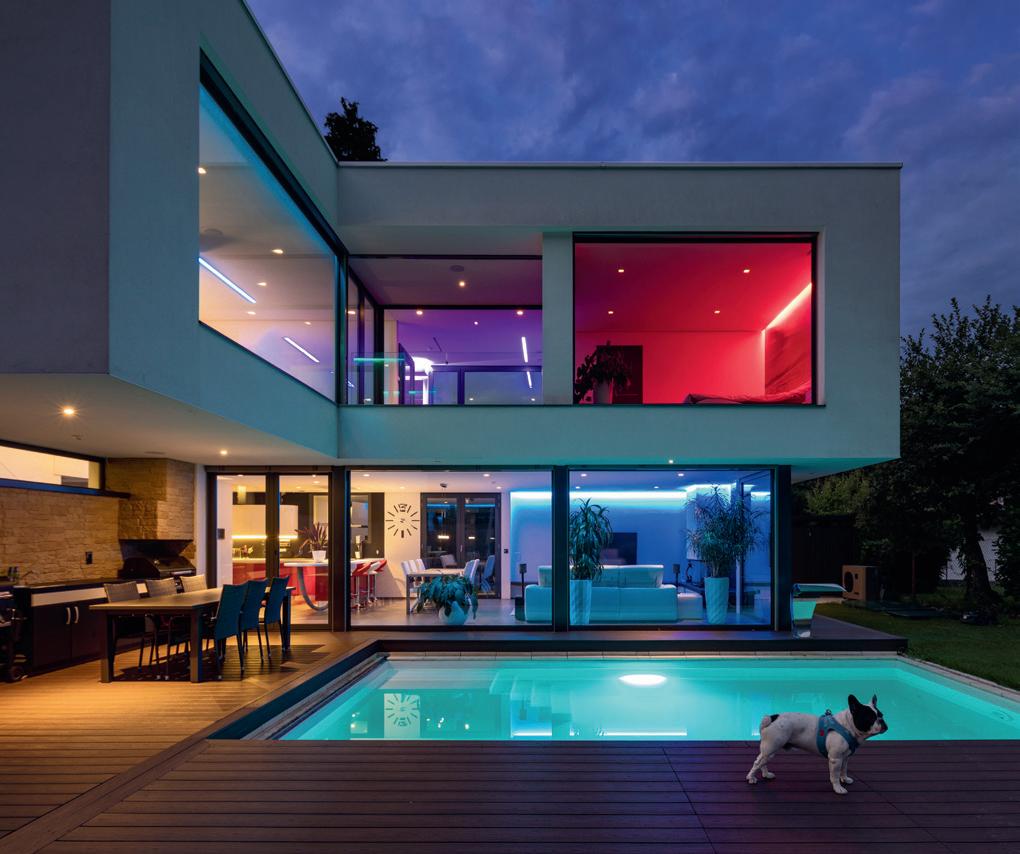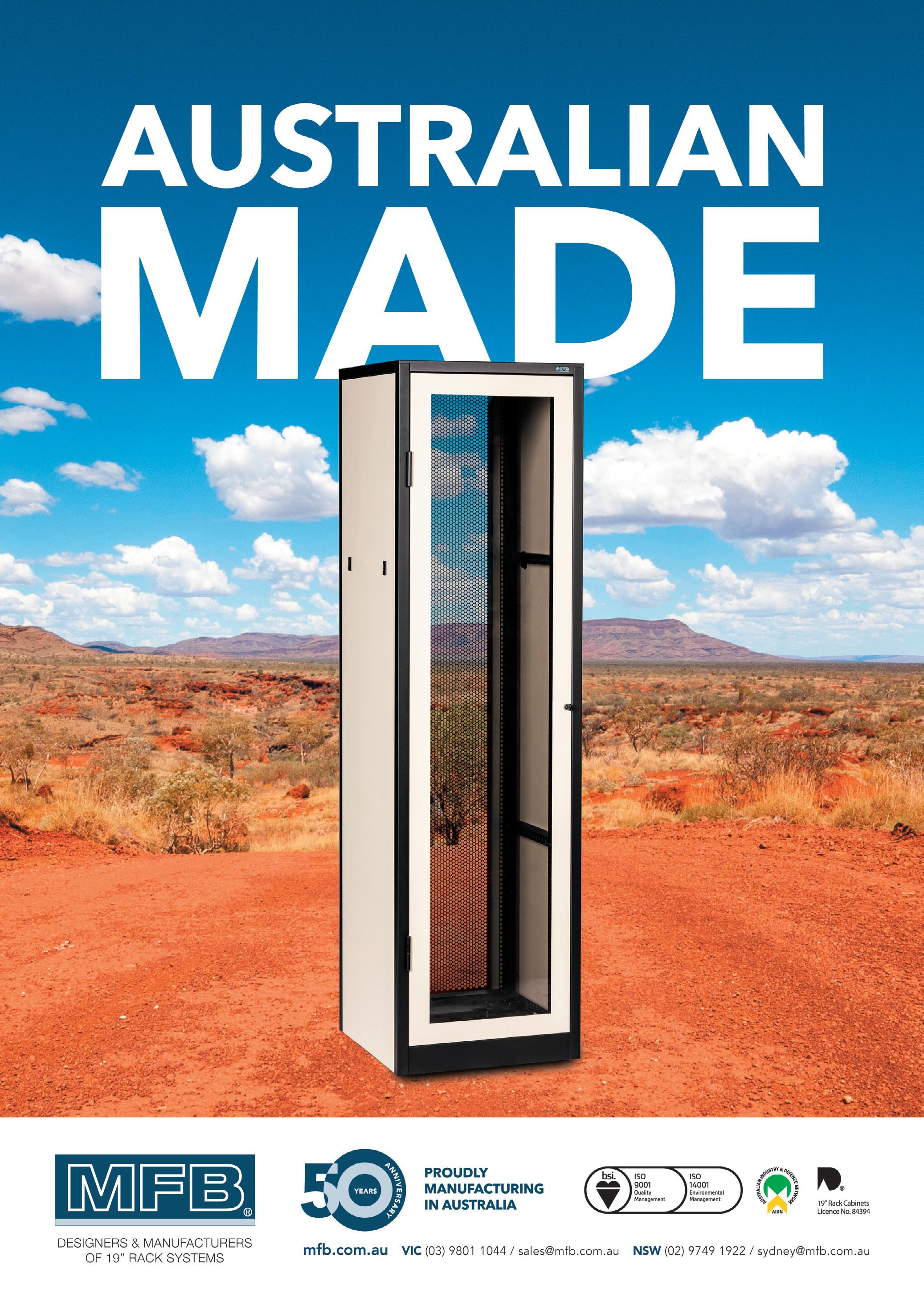
14 minute read
Where to from here? Smart homes in a postpandemic world
WHERE TO FROM HERE?
SMART HOMES IN A POST-PANDEMIC WORLD
Dannielle Furness

Plenty has been written about life after COVID-19 and what it will mean for work, travel, entertainment and our day-to-day lives. So, what changes will ‘the new normal’ bring for the home automation industry?
Once upon a time, control and automation was reserved for high-end homes — luxury residences complete with home theatre, access controls and intelligent lighting systems that were the exception, rather than the rule.
Pulling all those elements together took some serious integration capability and a reasonable amount of money. While the technology may not have been in the mainstream then, there was continual promise that the smart home would soon be within reach of everyone.
Flash forward to 2021 and home automation technology is easily available to the average consumer, but how does the ever-increasing range of affordable, disparate wireless devices stack up against an engineered solution comprising a dedicated wired network full of intelligent devices capable of complex conditional logic? Are they chalk and cheese, or does one inevitably lead to the other... and does it even matter?
Home, sweet home
Collectively, we’ve obviously all spent more time at home throughout the last year and a half. That’s been good news for suppliers of smart products at the lower end of the automation scale — devices including smart plugs, lightbulbs and cameras, along with mini speaker/automation hubs like the Amazon Echo Dot or Google Nest Mini. Combined with a smart phone and a voice-activated AI assistant, consumers can use these devices to initiate low-level home automation and control music, lighting and implement a basic security set-up.
For plenty of people, that’s enough... for now.
But that’s not really how things generally play out in the longer term. Once we’ve had a taste of additional lifestyle benefits or increased convenience, we humans tend to stick with labour-saving devices and technologies that deliver better outcomes. No-one went back to the horse and buggy or doing laundry by hand once the alternatives arrived, after all.
Can I help you?

The ‘traditional’ smart home market has always been fragmented, with vendors typically offering solutions that operate within their own discrete ecosystem. As the market matured, it became more commonplace for these vendors to make APIs available to other solution providers to make interoperability easier to achieve, but it’s still pretty much every man for himself at the foundation.
That situation still applies to today’s entry level automation options, with massive tech companies like Google, Apple and Amazon (I think we can agree Amazon is no longer a ‘retailer’) centring their smart home hub products around their virtual assistants. Your choice of smart home solution is now driven by the phone you already own along with the assistant and ecosystem you are accustomed to or are willing to adopt.
The AI-powered virtual assistants are the strength of these products and their increasing capability will begin to rival the ‘scene setting’ functionality offered by more mature automation solutions, where multiple actions can be carried out by a single command — where a phrase like “Goodbye House” can initiate lights off/on, security armed and blinds down, for example. Beyond that, the real hope for AI is the pre-emptive capability the assistants will offer. As they become more familiar with the behaviours and habits of users, they put those learnings to work and make system adjustments without any intervention.
In making these virtual assistants indispensable, tech vendors are ensuring their products are relatively sticky in the hope of fostering a long-term connection with users. Traditional home automation systems are also inherently sticky, though not necessarily for the same reason — it’s more likely because they are hard-wired in and are expensive enough to make changing to another system a bridge too far for many homeowners.
Topping out device numbers
ogy, which can exhibit significant limitations when it comes to device numbers and reliability — an area where wired alternatives tend to have an edge.
For many homeowners, wireless networks were stretched to the limit through COVID-19, with parents and kids competing for bandwidth while working and studying at home. Privacy and security concerns subsequently also rose in recognition of the fact that every connected device increases network vulnerability. Throw a proliferation of smart home devices into the mix and things start getting messy.
The devices themselves are often the cause of privacy concerns, with consumers questioning the security of speakers and hub devices that are programmed to continually listen for trigger words.
This combination of issues makes a wired network solution a compelling option for concerned homeowners, particularly in the face of an increasing number of smart device options including appliances like fridges, washing machines and microwaves.
Blending lifestyle improvement with environmental concerns
Early smart home systems were basically adaptations of lighting control and building management systems, where sales arguments were heavily skewed towards the energysaving benefit offered by these solutions and their substantial impact on the bottom line — something close to the heart of commercial building owners, operators and tenants.
In residential environments, energy saving may have been a concern for some consumers but it was usually overshadowed by the lifestyle benefits offered by smart homes — convenience, aesthetics and prestige.
Things look a little different in 2021, with climate change and environmental concerns top of mind for many consumers. While more likely to incorporate climate control in their homes, today’s homeowners are equally keen to ensure they are environmentally responsible. Consumers are as interested in where the power they use comes from as they are in how much they are using — it’s a notably different mindset from, say, 20 years ago and has helped Australia achieve one of the highest uptakes of rooftop solar systems in the world.
This new attitude is driving expectation around monitoring and reporting from smart home systems, whereby energy consumption is tracked and reported.
©stock.adobe.com/au/visivasnc
Convenience, connectivity and sanctuary
While COVID-19 lockdowns drove many workers and homeowners to ‘simpler’ distractions — like baking bread or learning an instrument — they also heightened the benefit of smart home technology backed by reliable connectivity.
With homes designated the epicentre of pandemic existence, many of us were obliged to use — and share — the same space for work, health, rest and entertainment. Wanting to improve that space was an obvious effect, with sales of homewares, appliances and electronics soaring in the early days of lockdown.
As long as international travel remains off the table (for the most part) and our vaccination programs suffer fits and starts, it’s still hard to estimate when things will officially be ‘back to normal’ — or if they ever really will.
For the home automation industry, this isn’t such a bad thing. As consumers learn to trust and rely on existing devices and assistants, and to venture into the automation space with entry-level products, the market potential grows. We know that ‘nice to have’ eventually becomes ‘can’t live without’ and that consumers will seek the solutions that offer the best alternative for their particular set of concerns, including convenience, connectivity and security. If the pandemic has taught us anything, it’s that uncertain times cause us to seek comfort, connection and sanctuary... which sound like ideal conditions for the smart home industry.














Pierlite has been appointed by Schools Infrastructure NSW (SINSW) to provide LED lighting across a large number of NSW public schools as part of the statewide Lighting Upgrade Program (LUP), designed to improve the wellbeing of students and teachers, provide energy savings and create hundreds of NSW jobs.
Pierlite will supply LED products to up to 1000 NSW public schools, replacing existing fluorescent lighting and aiming for a reduction in energy consumption of at least 50%. The majority of components and labour will be sourced from NSW-based businesses and manufactured at Pierlite’s Padstow facility.
The company’s solution is centred on its range of Vandalux and Unilux EP upgrade kits, offering energy savings, reduced environmental waste and wellbeing benefits to those interacting in the installed spaces. Additional benefits include a 50% faster install time, reduced installation risk and a lower risk of exposure to ceiling contaminants.
The initial phase of the project will see a number of new jobs created at Pierlite, its component suppliers and service providers.
The LUP has been designated as a COVID-19 economic stimulus recovery program. In addition to delivering operating cost reductions in electricity and maintenance, the program aims to support student learning behaviours by improving the indoor lighting environment across NSW public schools.
Pierlite Australia CEO Gustav Arianto said, “This is a strategically important contract for Pierlite and we are proud to partner with SINSW to ensure successful outcomes for NSW public schools.
“Our commitment to local job growth and manufacturing has always been a strong focus for Pierlite. Throughout the 70 years we have been operating here in NSW, we have continued to invest locally to retain our industry-leading innovation, design and testing capabilities at our Padstow facility, despite significant technology and market changes in our industry.
“We are delighted with the job creation and local manufacturing opportunities this contract provides — especially as our state economy recovers from the COVID-19 pandemic. We look forward to delivering products that will result in lower energy usage and less maintenance for NSW public schools, and will support student learning for years to come,” he said.

©stock.adobe.com/au/vectorfusionart ©stock.adobe.com/au/jc1305us
THREE INCIDENTS SPARK CONCERN ABOUT WORKING UNDER POWERLINES
Three serious incidents in regional Victoria throughout April have Energy Safe Victoria (ESV) Commission Chairperson Marnie Williams pleading for machinery operators to take more care when working near overhead powerlines.
On 12 April a crane truck offloading building material connected with powerlines in Dromana, with the crane arm making contact with 22 kV lines and injuring two men.
On 27 April a man suffered a severe electric shock and was left in a critical condition after a grain auger hit powerlines in Harston. The auger was being towed by a forklift the man was standing on when it hit one of the bare overhead powerlines. A second person driving the forklift received a shock but did not require treatment.
In a third incident, on 30 April a tip truck hit a high-voltage conductor at Trafalgar South, resulting in hospitalisation for the driver.
The three incidents are all being investigated by ESV and WorkSafe.
“To have three in the space of 18 days is deeply concerning,” Williams said.
“Anyone operating machinery such as cranes, crane trucks and tipper trucks must look up because incidents like these are preventable if operators of machinery take the proper precautions.
“They need to be aware of powerlines — particularly in rural and regional areas, where single bare powerlines are often hard to see.
ESV is unable to comment on the specifics of these incidents as they are still being investigated.
In late 2020, a farmworker was killed when the extendable boom on the telehandler he was operating came into contact with overhead powerlines in Gerung Gerung, in north-western Victoria.
The Look Up and Live campaign has been running for almost 10 years. It calls on workers and operators of such machinery to be aware of powerlines and plan how to safely undertake their work before they begin.
ESV recommends the following: • Understand No Go Zones. These include rules and distances for safety clearances near overhead powerlines. People and equipment working anywhere near powerlines need to understand the No Go Zone requirements to stay safe and away from live powerlines • Monitor weather conditions closely — powerlines can sag in extreme heat and sway in strong winds. • Remember that powerlines are more difficult to see at dawn and dusk. • Remember that electricity can jump across air gaps.

©stock.adobe.com/au/denisismagilov

FACTORING HUMAN INTERACTION INTO SMART CITIES
Technologies in urban spaces are monitoring weather conditions, understanding pedestrian foot traffic, determining when bins need to be emptied and monitoring public spaces through CCTV — but how do the city’s residents understand and interact with these technologies?
A recent project between the City of Melbourne and the Emerging Technologies Research Lab (ETLab) at Monash University is looking at the experiences and perspectives of emerging technologies in and around Melbourne’s CBD, to better plan for inclusive future cities.
Just like any other major city, emerging technologies are adopted to improve urban efficiency. Technologies like artificial intelligence (AI), Internet of Things (IoT) and 5G are just some of the advancements that are improving the quality of life for many residents. Despite the benefits emerging technologies can offer, they’re often deployed without the proper consultation of local residents.
Taking a more transparent approach, this project will combine research expertise with industry knowledge to engage the community in the early process of testing new technologies.
“This is an important initiative to provide a community lens on emerging technologies that have the potential to transform the way we run the city for the benefit of all Melburnians,” said Councillor Le Liu at the City of Melbourne.
The team of researchers from the ETLab, which is part of the Faculty of Information Technology and the Faculty of Art, Design and Architecture at Monash University, will employ a three-pronged approach that focuses on awareness, perception and partnership.
“By helping the City of Melbourne engage with the local community early in the process of testing new smart technologies and planning the future city strategy, this project will contribute important insights into how people perceive, value and use emerging technologies in the urban environment,” said Professor Sarah Pink, Chief Investigator and Director of the ETLab.
The second phase of the project extends upon this research and launched a live activation in Argyle Square as part of Melbourne Knowledge Week (26 April–2 May).
Locals were able to interact with each emerging technology by scanning QR codes dotted throughout Argyle Square that explained the role of each technology. By providing their feedback and interacting with the technology, members of the community were able to take part in the live experiment and play a vital role in shaping their city.
“This partnership employs a transparent approach to data collection, which is also why it was so important for us to include the local community and invite them to take part in our live experiment,” said Professor Pink.
The findings and information gathered from this partnership between the City of Melbourne and the ETLab have the ability to be replicated in other urban spaces and major cities.

©stock.adobe.com/au/alexandre zveiger
Lighting Council Australia (LCA) has published a new Creative Lighting Guide designed in the main for electrical contractors and consumers.
The guide provides a complete introduction to lighting including the basic tenets of lighting design, along with available technologies and their uses to achieve desired effects.
Lighting is used to enhance space, define beauty and maximise value. It is a critically important element in the use of a specific space and the desired mood to be created in that space.
The guide outlines the human response to light and the different types of light that can be used to highlight architectural features, add interest, relax or stimulate and provide functional outcomes for various tasks from simply safe movement through to detailed work. It also uses various images to illustrate real scenes and the lighting used.
The LCA says that guide users should note that Council Australia members agree to abide by our code of conduct and supply products that comply with Australian regulations and standards.








